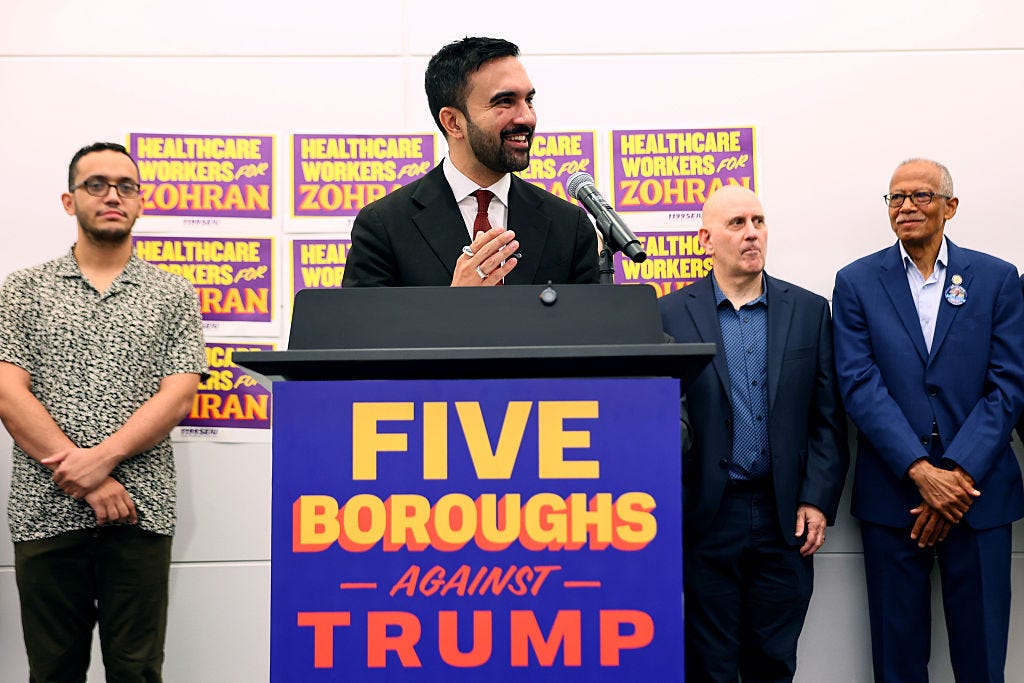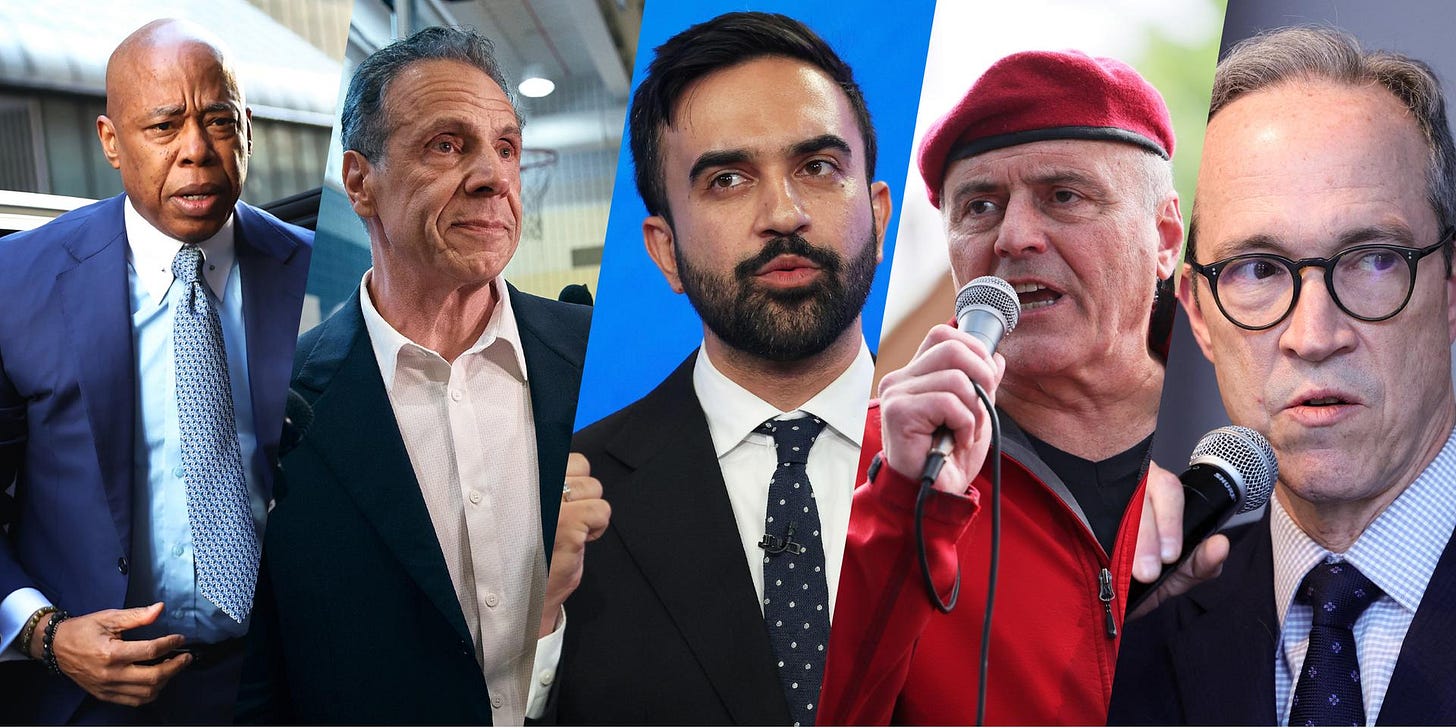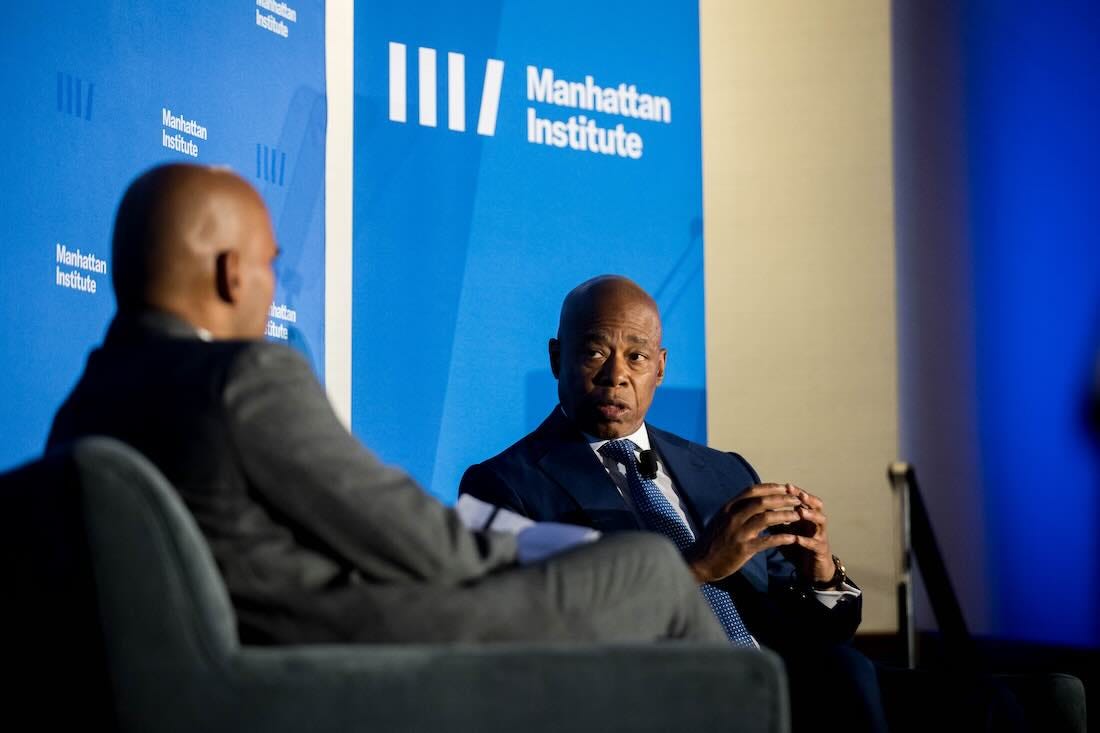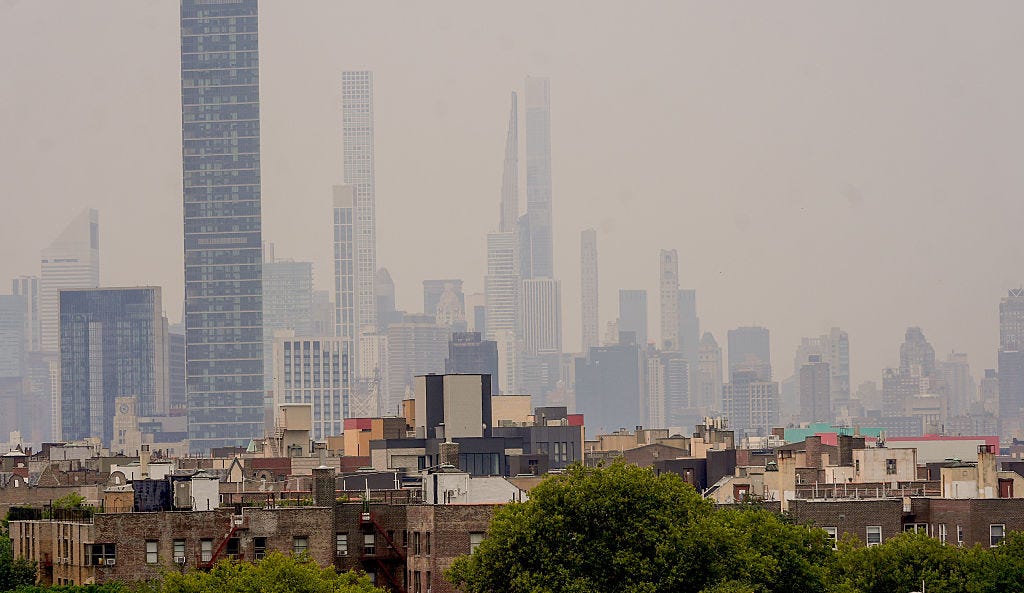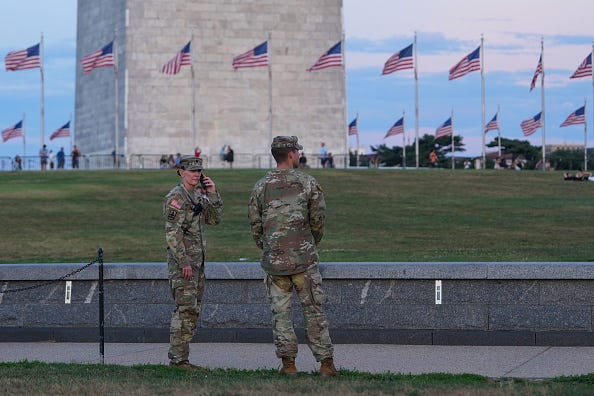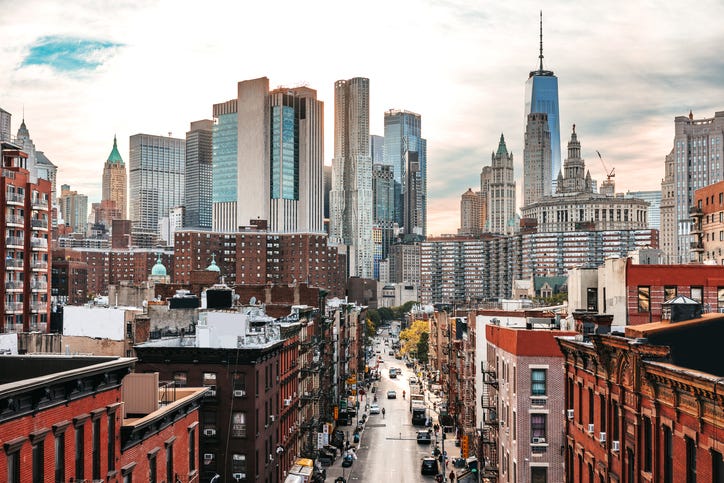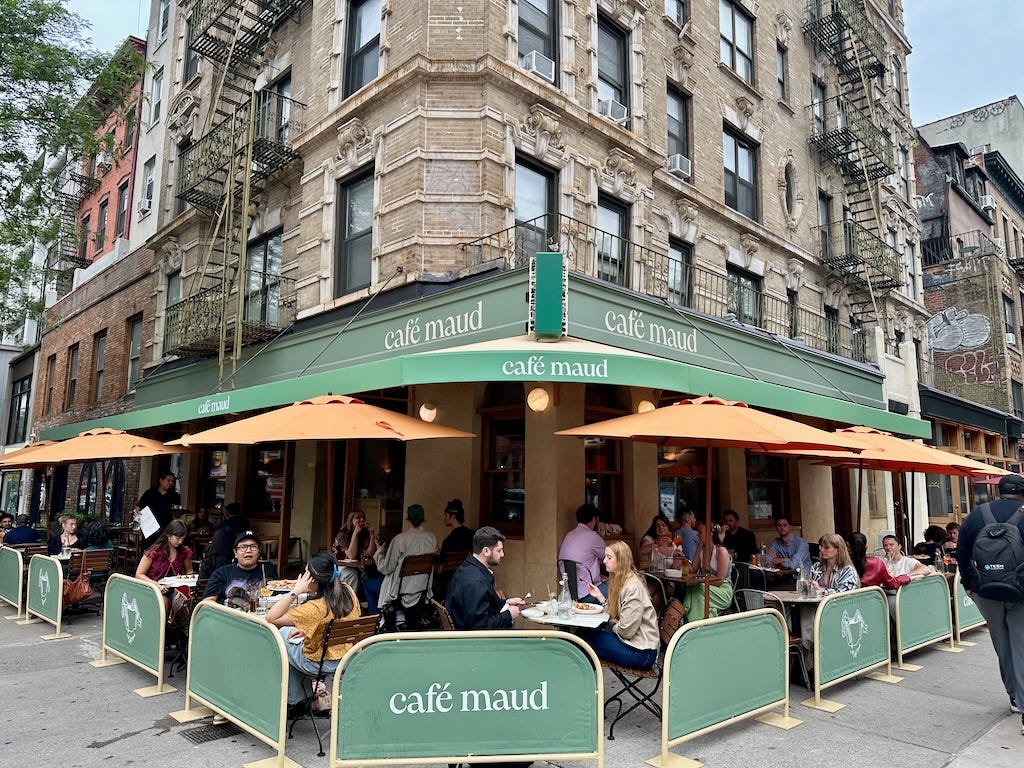Fighting Trump Won't Fix New York
New York’s biggest problems predate Trump: sky-high rents, stagnant wages, chronic homelessness, a shrinking middle class.
Few things unite New York City voters like opposition to Donald Trump. Zohran Mamdani knows this. Fresh off an underdog primary win, he’s pivoted from housing, wage, and transit proposals to branding himself “Trump’s Worst Nightmare,” launching a Five Boroughs Against Trump tour and turning November’s race into a referendum on resisting Washington.
The strategy is a shrewd piece of politics. Trump’s threats to cut funding, deploy federal forces, and override local protections make defending the city feel urgent. Mamdani’s focus is on disqualifying his rivals, Andrew Cuomo, Eric Adams, and Curtis Sliwa, by connecting them to the menace in the White House.
But New York’s biggest problems predate Trump: sky-high rents, stagnant wages, chronic homelessness, a shrinking middle class. These are the result of decades of policy drift, slow housing growth, and burdensome taxes and regulations.
A hostile White House can freeze billions in grants, tie the city up in court, or use federal forces to undercut local protections—but the structural forces driving the city’s decline are still largely homegrown, and its fate is decided mostly in City Hall and Albany. Trump (and the State) may cut funds, but by law, the city still has to deliver a balanced budget.
That’s where Mamdani’s pivot falters. His marquee ideas—a rent freeze, free buses, city-run grocery stores—sound bold but lack workable funding or implementation plans. A rent freeze without new construction incentives risks further tightening supply. Free buses demand subsidies the MTA can’t sustain. City-run groceries would require capital and management capacity City Hall has never shown. Higher taxes could push out the very businesses and earners that fund city services.
Cuomo offers caution, Adams touts management, Sliwa promises confrontation without details. All face the same test: keeping New York functioning as Washington turns hostile. Mamdani bets that pure resistance will outweigh the need for pragmatic deal-making. But leading protests is not the same as leading this city. In a crisis—ICE sweeps, union pushback, frozen federal funds—voters will judge a mayor on whether trains run, classrooms are staffed, and streets are safe.
Polling shows Mamdani strong with younger progressives, but most voters—Democrats included—want a mayor who defends city values while working with Washington when necessary. They value results as much as defiance. But the same things that make him appealing to his base are already alienating many New Yorkers: Polling shows Mamdani with surprisingly high negatives for a first-time candidate, and whatever his persona, a Mamdani mayoralty promises to be intensely divisive.
This election shouldn’t be just about who can stand up to Trump, but about who can govern through a siege and tackle the crises we built ourselves. Slogans don’t fill potholes, balance budgets, or build housing. Mamdani has said repeatedly he's "looking to work with anyone so long as it's to the benefit of New Yorkers." But will he be able to?
Campaign Update
Mamdani doubles down on Trump fight — Front-runner Zohran Mamdani is leaning hard into his “Trump’s Worst Nightmare” frame, launching a five-borough anti-Trump tour and recasting the race as a referendum on defending NYC from Washington overreach (NYT, Politico, Guardian, The Nation, NY Post). The shift sidelines earlier policy rollouts — but also exposes him to budget-gap critiques (Post), rent-deal scrutiny (Post, NYT explainer), and doubts over the political muscle needed for his NYPD overhaul plan (Gothamist).
Cuomo as the underdog — Andrew Cuomo is trying on a humbler persona (Politico), pushing income caps for rent-stabilized units aka "Zohran's Law" (Crain’s), and leaning on PAC allies for anti-Mamdani attacks (Crain’s). A Siena poll shows Mamdani far ahead (Siena PDF, NY Mag).
Adams holds his lane — Mayor Adams, trailing in polls, is banking on his crime-and-infrastructure record. He picked up former Gov. David Paterson’s endorsement (Gothamist), celebrated council approval of the Midtown South rezoning plan to deliver 10k homes and a 34th Street busway (Gothamist), and continued campaigning despite a $3.1M debt in his defense fund (NYDN) and a top aide’s guilty plea in a fundraising scheme (The City).
Orthodox Vote — How will Orthodox Jews vote in the mayoral election? This influential voting block may be more divided this year, Josh Appel writes (City Journal).
Eric Adams Talks To Reihan Salam
Yesterday morning, the Manhattan Institute hosted Mayor Eric Adams, who unveiled the “Compassionate Interventions Act” and sat for a Q&A with MI President Reihan Salam.
The mayor proposed a state law that would allow medical professionals, with court approval, to involuntarily hospitalize drug users who are a danger to themselves or others when voluntary treatment has failed. Building on his earlier mental health policies, the plan includes $27 million for contingency-management addiction therapy, expanded outreach, $14 million for syringe service programs, and a new Bronx drop-in center.
“Today I’m putting forward our proposal for those who have been considered a lost cause,” Adams said, arguing that addiction “tears apart lives, families, and entire communities” and that government must not “give up on anyone.” He framed the legislation as the next phase of his effort to address both public health and public safety, alongside targeted enforcement in drug-use hotspots.
In conversation with Salam, Adams said that winning legislative backing would require moving past partisan framing and countering what he called a “numerical minority” in Albany and the City Council that blocks quality-of-life reforms. He urged think tanks and civic groups like ours to help “educate the public” through op-eds and commentary.
Manhattan Institute fellow Charles Fain Lehman, writing in the New York Post, supports the proposal, noting that research shows involuntary treatment can be as effective as voluntary care and that New York’s shortage of long-term treatment beds makes such authority essential.
You can watch the recording of the event here.
Who Gets to Live Here?
Rent stabilization and co-op housing in New York were born of utopian ideals: protecting ordinary tenants and fostering democratic ownership. Yet both now serve as gatekeepers in a climate of scarcity.
Over 960,000 rent-stabilized apartments are regulated by a mayor-appointed board; critics like the Manhattan Institute’s Eric Kober note that decades of capped increases have left many units—sometimes occupied by affluent tenants—renting far below market, making the system resistant to reform and its benefits poorly targeted. Debate around Cuomo's “Zohran’s Law” underscores the tension between original purpose and real outcomes.
Co-ops, designed for community and stability, now often rely on opaque board approval processes that filter who can buy in, regardless of means. Despite lofty origins, both systems today ration access to housing and protect insiders, falling short of the broad, equitable city promised by their advocates.
Further Reading:
What Is Rent Stabilization, and Why Is It an Issue in the Mayor’s Race? (NYT gift link)
The Ubiquitous, Ridiculous, Coveted New York Co-op How a quasi-utopian housing model became a de facto standard and persists to this day. (New York Magazine)
From the Archives: Empire State of Crisis by MI's Nicole Gelinas
D.C.–Trump Showdown Reverberates In NYC
After deploying the National Guard and taking control of D.C.’s police, Trump has hinted other Democratic-run cities could be next (Patch, The City, Guardian, Semafor). Legal experts say NYC’s home-rule protections make such a move harder here (Gothamist), but the episode has sharpened mayoral race contrasts on policing and federal power.
D.C. is different. "[When] Democrats nitpick whether crime in Washington has been getting better or worse lately, they miss the larger point: violent crime in Washington is (and has been) alarmingly prevalent all along, reflecting a joint failure by the local and federal governments that share responsibility for public safety and crime prevention in the city," Josh Barro writes. Boston, comparable in size, had 23 murders last year, to D.C.'s 187. New York, about 12 times bigger, had 377.
MI’s John Ketcham and Charles Fain Lehman caution in City Journal that while there is legitimate public anxiety in D.C.—sparked by a high-profile assault—the real issue runs deeper: unlike elsewhere, D.C.’s laws give Congress and the President considerable intervention tools, from vetoing local legislation and budget authority to emergency policing powers.
Instead of dramatic federal overhauls or abolishing home rule, Ketcham and Lehman argue for strategic, constructive steps: authorizing federal funds to bolster MPD staffing and jail infrastructure; streamlining judicial appointments to reduce vacancies; and, if necessary, creating a temporary oversight board to ensure public safety without sacrificing local governance.
Other News
NYCHA camera expansion — While public debate swirls over public safety, Mayor Adams has been quietly using NYCHA’s free broadband program to add more NYPD surveillance cameras in public housing (NY Focus).
Transit & mobility — S&P upgraded the MTA’s credit after congestion toll revenue and a state tax hike (Crain’s); the city unveiled a new greenway master plan (Gothamist); and Revel is shutting down its electric ride-hail service in NYC (NYT).
Schools — City reading scores are showing significant gains after Adams’ literacy overhaul (Gothamist, NYT), but more than 40% of students are still not proficient (Post).
Housing & cost of living — Midtown South rezoning received council approval; promises 10k new homes (Gothamist), the city will close its last large migrant hotel (NYT), and median-income New Yorkers are paying $3,200 for 275 sq ft in Manhattan (Curbed).
Meeting Place
Café Maud at 132 2nd Ave (at St. Marks Place) is an excellent East Village spot for casual meetings in a relaxed atmosphere. There are plenty of seating options, reliable coffee, a menu that works for any time of the day, and staff who won't rush you. Think European café with modern New York comfort. Hours are 9 am to midnight, later on weekends.


